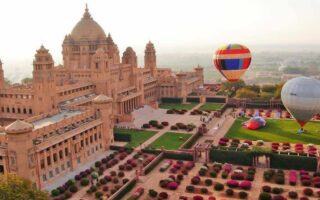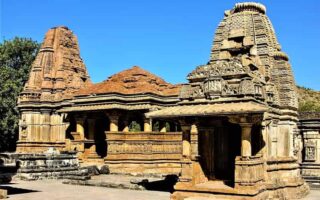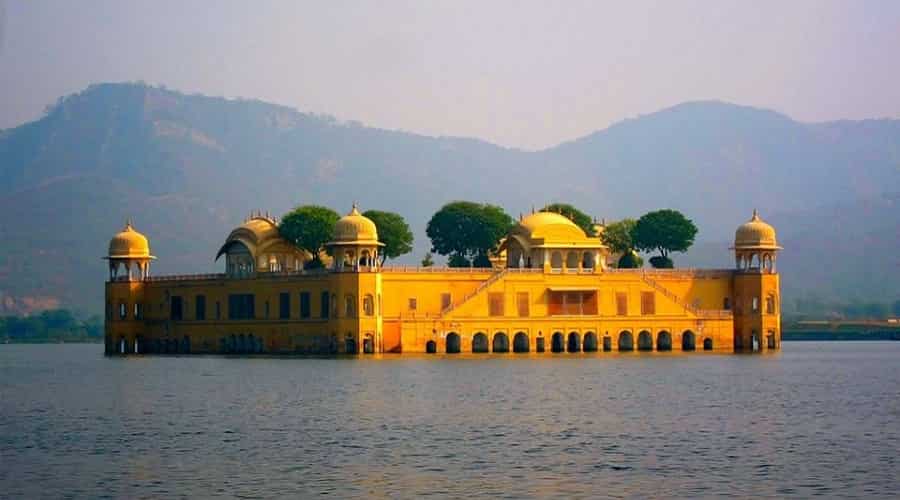Jaipur is the capital of Rajasthan. It is also known as the pink city. Jaipur is predominantly a city of palaces and monuments. Jaipur is representative of the desert state. It has tons of barren wilderness. However, Jaipur is also a city of gardens. There is immense flora and greenery around Jaipur. The gardens in Rajasthan are wonderfully landscaped. They serve as a visual treat. Sawai Raja Jai Singh, who was Jaipur’s founder, was clearly far-sighted. Vidyadhar Garden and Kanak Vrindavan Valley are popular gardens in Rajasthan.
Kanak Vrindavan is situated at the foothills of Nahargarh Mountains. This wonderful landscaped garden can be viewed while you tour three forts: Amber Fort, Jaigarh Fort, and Nahargarh Fort. The garden has a wonderful temple carved out of beige stone. The temple is replete with marble pillars and lattices.
Sawai Jai Singh in 1728 built a garden for his Sisodia queen, who was from Udaipur. The garden was known as Sisodia Rani ka Bagh. The garden is situated nearly 8 km from Jaipur on the road to Agra. The garden has a Mughal-style landscape. It depicts the legendary figures of Radha and Krishna. There are many tiers to the garden. In addition, it has watercourses, beds of flowers, and fountains. The palace house has painted pavilions. The murals depict the stories of Lord Krishna.
Ram Niwas Garden is one of the most popular gardens in Rajasthan. The garden has wonderful surroundings of fountains, rows of flowerbeds, and pools.
Another popular garden in Rajasthan is Gulab Bagh. It means ‘Garden of Roses’. It is located in Sajjan Niwas Park in Udaipur. The garden is home to numerous species of rose from all parts of the globe. Aravalli Express is a toy train that lets you tour the garden.
Saheliyon Ki Bari is a famous garden in Rajasthan. It literally means ‘Garden of the Maids of Honor’. It is situated in Udaipur. It was specifically built for the damsels of the royal household. The garden is well planned. There are huge lawns with shady pathways. The nearby Fateh Sagar Lake is a treat for the eyes.
Bada Bagh, Jaisalmer
- Timings: 9:00 AM – 6:00 PM
- Time Required: 1-2 hrs
- Entry Fee :
- Indians: INR 20 – 50
- Foreign Tourists: INR 50 – 100
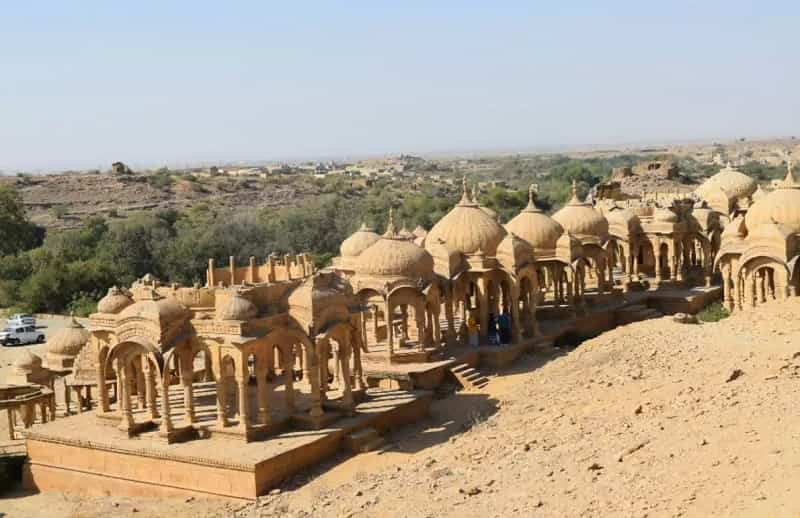
Bada Bagh is situated three kilometers north of Jaisalmer. Bada Bagh serves as a fertile oasis. A mammoth ancient dam lies along the banks of the artificial lake. The backdrop of the lake and dam make a pretty picture. The dam is situated at the centre of the plateau. This enhances the overall beauty.
The city gets its supply of fruits and vegetables from here. Women in colorful attires carry these to the town every day. Royal cenotaphs are situated above the gardens. They are surrounded by dense, green trees. The cenotaphs are intricately carved. The region is famous for its equestrian statues of prior rulers.
The region between the desert and lake is dedicated to cremation grounds for the royal family. It was constructed by Maharaja Jai Singh II. The lake dries up every year. Hence, a wheat crop is cultivated here. Each memorial is known as ‘Chhatris. Each one is replete with a central column.
One can see a marked style progression. The garden has angular shapes, which are characteristic of ancient Hindu Monuments. These are more than 300 years old. The round arches refer to the Moghul influence. Bada Bagh is situated at the bank of a dam constructed by humans. The garden is surrounded by greenery, which gives a healthy respite from the scorching sun.
During dusks, the setting sun transforms Jaisalmer into a wonderful land with golden brown hues. The garden can be accessed at all times. In addition, there is no entry fee.
Maharawal Jait Singh commissioned the garden during the early 16th century. The construction work was completed by his son Lunakaran.
The site is composed of three distinct elements: the garden, tank, and dam. Govardhan Stambh, which is a pillar, lies in close proximity. In order to commemorate the dam and tank’s construction, the pillar was erected. The dam and tank are known as Jait Bandh and Jait Sar in the local dialect, respectively.
The Jait Bandh is an imposing structure. It is nearly 1,200 feet long. In width it measures 350 feet. Upon detailed observation, you will realize that the structure is built of solid stone blocks. The same blocks have been used in the well and tank construction.
Ram Niwas Garden, Jaipur
- Timings: 9:00 AM – 5:30, closed: on Tuesday
- Time Required: 2-3 hours
- Entry Fee:
- Indian Tourists: INR 10
- Foreign Tourists: INR 100
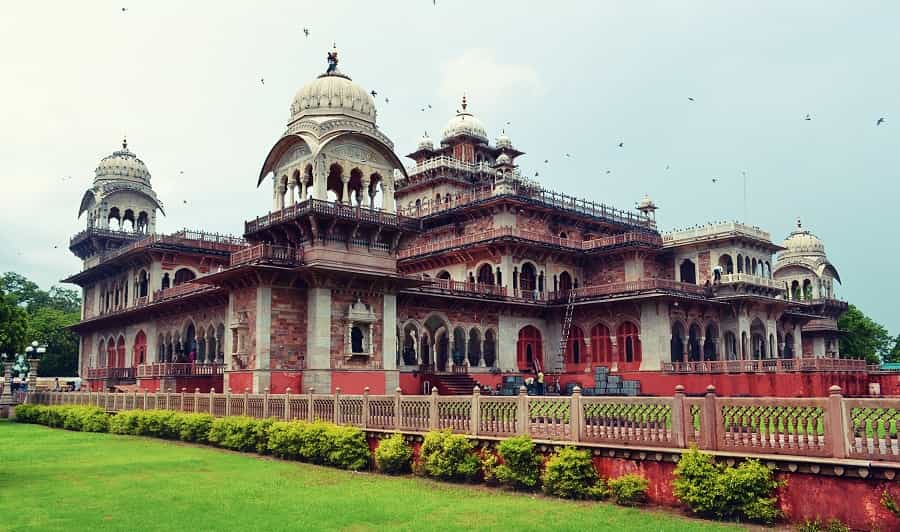
Ram Niwas Garden is one of Jaipur’s most beautiful gardens. The garden was built by Sawai Raja Pratap Singh in 1868. The garden has a number of tourist attractions.
Ram Niwas Garden serves as an oasis with its lovely, green cover. The garden was built with a specific purpose in mind. The garden has numerous attractions. It was designed to save Jaipur city from the vicious drought. Nearly four lakh Indian rupees were spent in building Ram Niwas Garden. This was a considerable sum in those times. No one expected Ram Niwas Garden to become a major tourist attraction.
Besides the garden, there are numerous, other attractions. Albert Hall and Zoological Garden are the major attractions within the garden. The garden’s Albert Hall is historically significant. The hall’s foundation was laid by Prince Albert, who was the Prince of Wales, in 1876. The hall is home to a famous museum. The Museum highlights the amazing history of Jaipur city. This adds a new dimension to the visit of Ram Niwas Garden.
When you are touring Jaipur, you must visit Ram Niwas Garden. A trip here will be a fantastic learning experience. The garden served as a project for famine relief. A tiny zoo and park for birds lie in close proximity. The atmosphere is splendid, but there is a dearth of animal species.
The Albert Hall was designed by Sir Swinton Jacob. It contains a fantastic collection of paintings, sculptures, decorative items, and specimens of natural History. The much-hyped Persian garden carpet is also housed here. The museum is also home to an Egyptian mummy. In recent times, an art gallery and open-air theatre have been added for the promotion of cultural activities.
Vidyadhar Garden, Jaipur
- Timings: 8:00 AM – 5:30PM
- Time Required: 2-3 hours
- Entry Fee: No entry fee
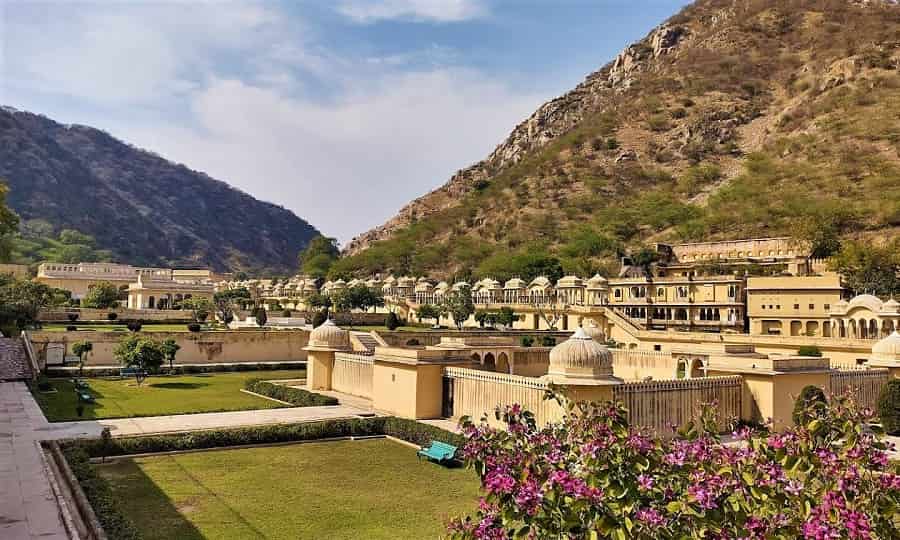
Vidyadhar Garden is a spellbinding garden. Rajputs belonging to Jaipur derived the garden from the definition of garden by the Mughals. Vidyadhar garden’s main purpose was to provide a sense of relief to the desert lands’ scorched scenery. The garden is located at the Jaipur-Agra road. It lies at a distance of 8 km to Jaipur’s East. Formerly, the garden’s purpose was to serve as a vineyard to rulers. It was subsequently refurbished and renovated to its present look and feel.
Of all the gardens in the awesome city of Jaipur, Vidyadhar Garden is the only one that is well planned. The garden was constructed in memory of Vidyadhar Bhattacharya, who was Jaipur’s chief architect and city planner. The garden’s design has been planned keeping in mind the edicts and rules of Shilpa Shastra. Shilpa Shastra is a line of architecture belonging to ancient India. Vidyadhar followed the same principles while he planned Jaipur.
The garden is situated amidst desert lands. It has plenty of watercourses though. This modifies the cityscape’s façade. One view of this garden is sufficient to refresh the minds of local inhabitants. After all, the garden is lush green and terraced. Vidyadhar garden occupies the valley created by two rocky hills. This adds to the countryside’s beauty. The fountains are arranged in a pristine fashion. Shady trees and flower beds merely enhance the garden’s beauty.
The garden has layers to it. It is home to numerous galleries, pavilions, and wonderful art frescos that depict Lord Krishna. These frescoes are a sight to behold. The garden offers breathtaking views of the monkeys and peacocks. The best time to visit the garden is during twilight. The garden’s outline is illuminated by the setting sun and its subsequent light. Adjoining hills serve as the garden’s backdrop. Vidyadhar Garden is a major tourist attraction for domestic as well as international travelers.
Gulab Bagh, Udaipur
- Timings: 9:00 AM – 5:30PM
- Time Required: 2 hours
- Entry Fee: Rs.25
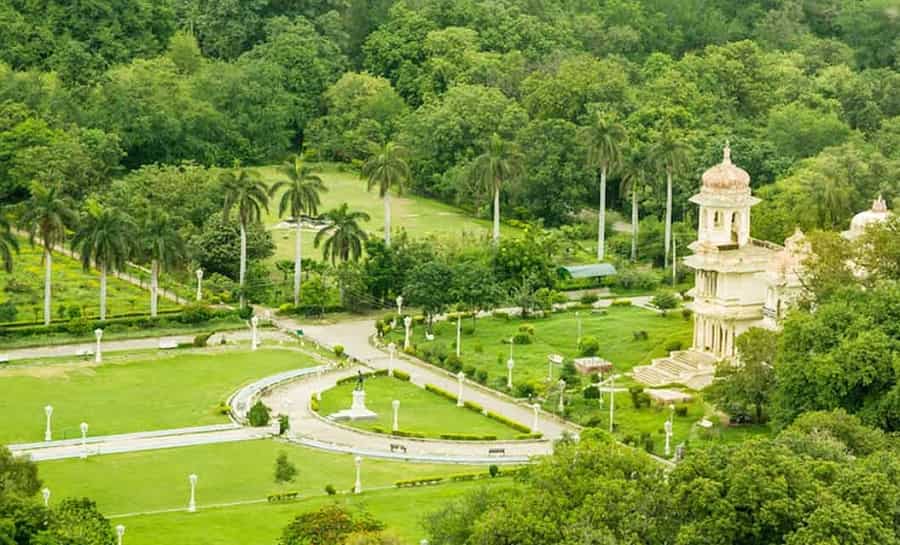
Gulab Bagh literally translates at Rose Garden. It is located at Sajjan Niwas Park, Udaipur. Sajjan Singh created the wonderful Gulab Bagh in the latter half of the 19th century.
Few Indian gardens are as enchanting as Gulab Bagh. Roses from all over the world are housed here. Gulab Bagh is home to roses of all hues and colors. This garden is a visual treat. Weary individuals will feel rejuvenated by a trip to the garden.
The garden is home to Saraswati Bhawan Library, which was originally known as Victoria Hall. It is a striking structure built to commemorate the diamond jubilee of Queen Victoria. The library is home to ancient manuscripts that are handwritten. Gulab Bagh is also known as Sajjan Niwas Garden. It is Rajasthan’s largest garden. It is spread over an area of 100 acres. Gulab Bagh is known for its wide variety of roses. The garden is popularly known as Gulab Bagh because of the abundance of roses. The garden is located below Pichola Lake’s banks. The garden is situated on Lake Palace Road. Gulab Bagh lies in the South-eastern region of the complex of the City Palace.
The garden has innumerable varieties of roses, many of which are alien to India. The flower bed arrangement is the hallmark of the garden. Gulab Bagh is peaceful and tranquil. Udaipur’s residents tour the park to relax and enjoy the sights. It is a paradise for nature lovers.
The robust trees, spacious lawns, orchids, and rose beds will mesmerize any visitor. A toy train is situated in the garden, which can serve as an amusement for kids. The garden is also home to a miniature zoo, which houses chinkaras, leopards, and birds.
Saraswati Bhawan Library was built by Maharana Fateh Singh. Many manuscripts dating back to the early medieval period are housed here. Various subjects such as archaeology, Indology, and history are covered. The garden is also home to a Museum, originally called Victoria Hall Museum. It has an intriguing collection of antiques, curios, and items belonging to the royal household. Ancient relics also make their presence felt.
Gulab Bagh was once regarded as the biggest urban park in all of India. Till today, the garden maintains its charm. Tourists from all over the world throng this magnificent park belonging to the 19th century. It is without doubt Udaipur’s best garden.
Saheliyon Ki Bari, Udaipur
- Timings: 9:00 AM – 7:00PM
- Time Required: 1-2 hours
- Entry Fee: Rs.10 for India, Foreigners Rs.50
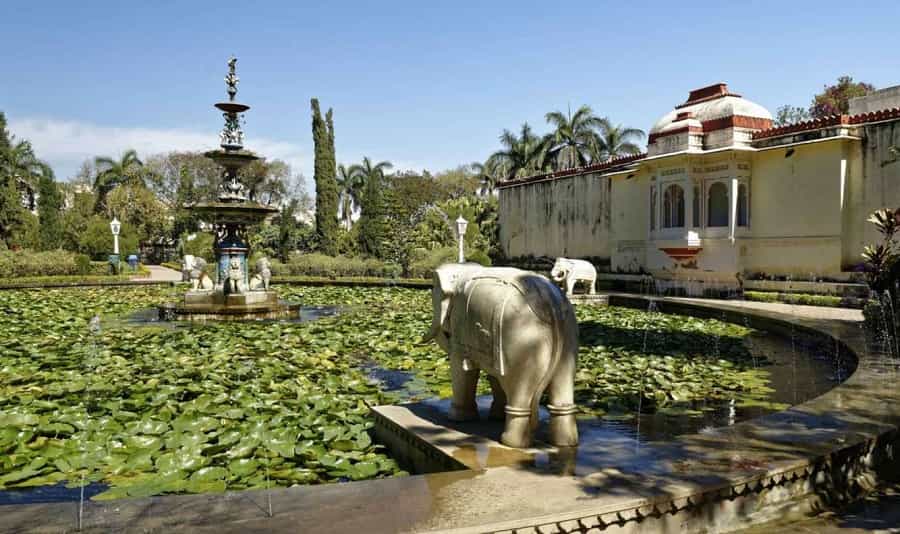
Saheliyon Ki Bari is one of the most splendid gardens. It is a major tourist attraction in Udaipur. The garden is renowned for its marble artwork, fountains, and lush green lawns. Saheliyon Ki Bari literally means ‘Garden of maids’. The garden is located at Fateh Sagar Lake’s banks. It serves as an oasis in Rajasthan’s arid lands. Maharana Sangram Singh built the garden in the 18th century for the ladies of royalty.
According to legend, the king himself designed the garden. The garden was then presented to the queen. In reality, 48 maids accompanied the Queen at her marriage. Saheliyon Ki Bari was built specifically for these maids. The garden served as a getaway from the court’s politics. The garden served as a wonderful spot for relaxation for the ladies of royalty. The Queen along with her maids and female friends frequented the garden for leisurely strolls. The garden gets its name from this fact.
The garden’s architecture is splendid to say the least. It offers some of the most breathtaking sights. The four pools of the garden are adorned with intricate fountains. The kiosks are chiseled, while the elephants are carved of the purest marble. Saheliyon ki Bari is famous for its bird fountains and lotus pool. The flowerbeds, pavilions carved out of marble and lawns that are lush green add to the romantic ambience of this mesmerizing garden.
Maharana Bhopal Singh developed a special liking for this garden. He subsequently constructed a pavilion comprising of rain fountains. The idea was to create an illusion of dancing in the rain in harmony with dancing maids. The kings spent several hours lying by the pool and garden fountains. Some of the fountains saw import from England. The garden’s primary reservoir comprises of four kiosks carved out of black marble. These lie at the corners. The centre kiosk is adorned in white marble. Sculpted birds are situated on the top of each kiosk. They spurt water, which produces the effect of rain.
Another popular attraction of the garden is the Museum, which has a mammoth collection of royal household exhibits. It is home to ancient pictures and souvenirs of the period that is bygone. The cobras and several other animals are well stuffed and look lifelike. These animals add to the trip’s adventure element. Strolling across the shady lawns is a popular activity. Here, a bougainvillea bunch will bend in order to greet you. Presently, Sahelion ki Bari has become ideal for recreation for the inhabitants of Udaipur.
Mandore Garden, Jodhpur
- Timings: 8:00 AM – 8:00PM
- Time Required: 1-2 hours
- Entry Fee: No entry fee, for Museum Rs.50
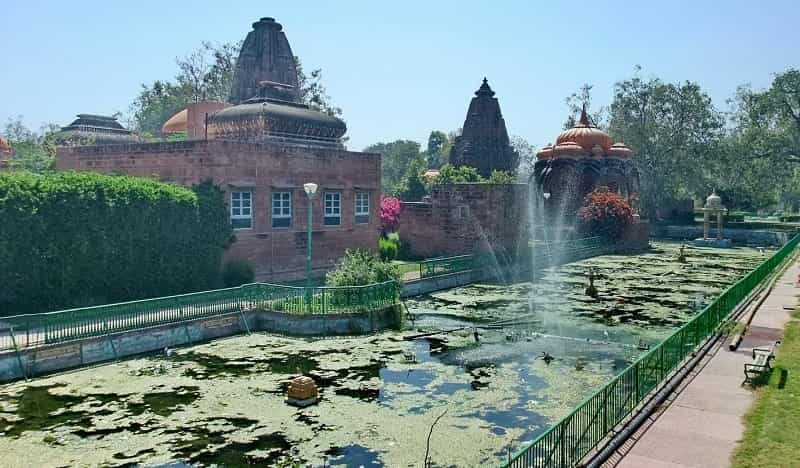
Mandore Garden is located 9 kms to Jodhpur’s north. Mandore served as Marwar’s capital prior to Jodhpur’s development. The city of Mandore is situated on a plateau that overlooks the majestic Mandore Garden. The gardens are extensive with high terraces made of rock. These features make Mandore Garden a wonderful local attraction. It is also an ideal picnic spot.
The city ruins of the original Marwar capital stand in lush-green and shady gardens. To enter the Mandore Garden you would have to cross Ajit Pole, which is an entrance gate built in commemoration of victory of Ajit Singh over the Mughal rulers in 1707 AD.
The garden is also home to wonderful cenotaphs of rulers of Jodhpur. There is a huge memorial dedicated to Maharaja Ajit Singh. The garden has a spectacular collection of memorials related to cremation sites. The garden is clean, green and hassle free.
The Hall of Heroes, which is graphic in nature, is the hallmark of Mandore Garden. The wall comprised of rocks is central to the garden. Local heroes, including Chamunda and Pabuji, have been depicted through bright paintings. The modern shrine is home to nearly 30 crore deities and gods.
Rajasthan fairs are predominantly mythological. They relate to goddesses and gods. Elaborate celebrations are undertaken to mark the valiant deeds of heroes belonging to medieval times.
Mandore Garden is a perfect venue for hosting the Marwar Festival. This festival commemorates the heroes of the state. Celebrations for this festival begin in Ashwin, which is a Hindu month. Jodhpur sees the bulk of the celebrations. It is, after all, Marwar Province’s former capital.
The garden is available for sightseeing between 8 am and 8 pm. Mandore Garden is home to cenotaphs or dewals of the former rulers of Jodhpur. The cenotaphs are unlike the general chhatri-shaped ones, which are characteristic of Rajasthan. The cenotaphs of Mandore Garden are similar to those found in Hindu temples. They stand at an impressive height of four stories. Each cenotaph is replete with elegant columns and a magnificent spire. All these are composed of red sandstone. Maharaja Ajit Singh’s cenotaph is the most impressive of all. The Maharani’s cenotaphs are situated on a hill’s rocky outcrop.
The Hall of heroes lies in close proximity to the cenotaphs. The hall stands dedicated to numerous, Rajput folk heroes and deities. Their statues are carved wholly out of rock. Bright colors are used for their painting. Mandore Garden is also home to the ‘Shrine of Three Hundred Million Gods’. Numerous Hindu gods and goddesses are depicted here. While you go up hill, you will encounter the ruins of Mandore city, replete with its ancient palace.
Sisodia Rani Ka Bagh, Jaipur
- Timings: 8:00 AM – 7:30PM
- Time Required: 1 hour
- Entry Fee:
- INR 50 – for Indians
- INR 200 – for Foreigners
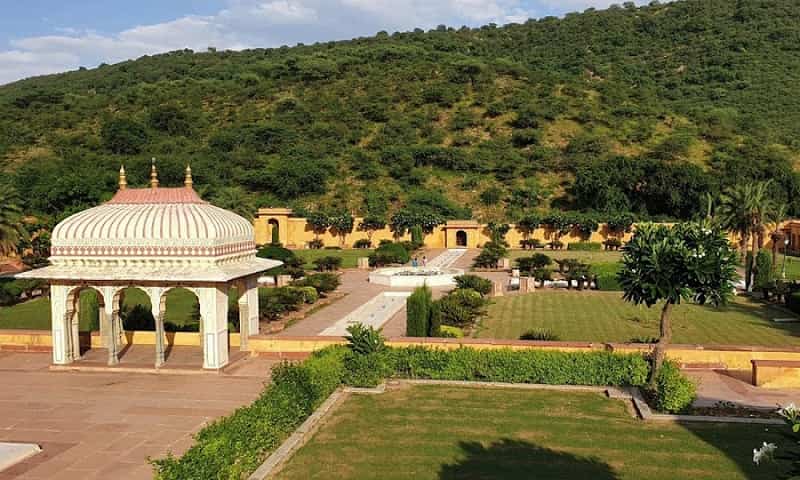
Sisodia Rani ka Bagh is situated on the road to Agra. It is located in a steep gorge in the walled city’s south-eastern corner. During the 18th and 19th centuries, numerous landscaped gardens were built by kings and their courtiers. Of all the gardens, the most famous and largest garden was built by Sawai Jai Singh II for his queen. The garden was named Sisodia Rani ka Bagh.
The garden has many tiers and levels to it. Sisodia Rani ka Bagh is replete with watercourses, painted pavilions, and fountains. Of all the gardens, the best-preserved is the Vidyadhar ka Bagh, built by the founder of the city: Vidyadhar. The garden is replete with wonderful, shady trees, a pavilion that is open, and majestic, flowing water. In addition, there are numerous suites.
Sisodia Rani ka Bagh is a wonderful garden separated from Jaipur by a distance of 10 km. It lies near the Jaipur-Agra Highway. Sisodia Bagh is a famous attraction of Jaipur, which is a charming city. Sisodia Rani ka Bagh serves as a symbol of love. It is an amazing sight to the beholder.
The garden served as a perfect getaway for Jaipur’s queen. The queen has spent lots of time here in utter relaxation amidst nature. The world of politics was left far behind at the Royal palace. The garden is home to aromatic shrubs and an exquisite collection of plants. It served as an ideal sanctum for the royalty. Sisodia Rani ka Bagh has been a haven for crowned heads and ladies belonging to royalty. However, in present times the garden is open to everyone.
The garden’s structure is heavily influenced by Mughal architecture. The garden has a wonderful design. The eternal love between Radha and Krishna seems to be the predominant theme of the Sisodia Rani ka Bagh. The garden strikes a chord with the spectator’s visual and artistic tastes. The garden is famous for its fountains and painted galleries and pavilions. The intriguing frescos depict Krishna and Radha in traditional poses. Their appearance seems divine, and it continues to enthrall its visitors.
Its charm and wonderful landscaping are what sets it apart from other gardens. The garden combines human skill with nature’s beauty. A visit to Jaipur is largely incomplete if you skip this garden. The garden is a true, visual treat.
